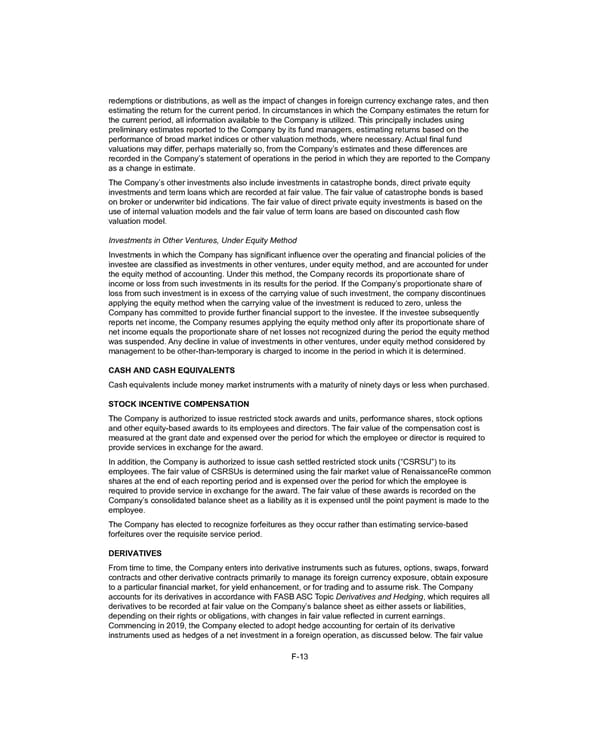redemptions or distributions, as well as the impact of changes in foreign currency exchange rates, and then estimating the return for the current period. In circumstances in which the Company estimates the return for the current period, all information available to the Company is utilized. This principally includes using preliminary estimates reported to the Company by its fund managers, estimating returns based on the performance of broad market indices or other valuation methods, where necessary. Actual final fund valuations may differ, perhaps materially so, from the Company’s estimates and these differences are recorded in the Company’s statement of operations in the period in which they are reported to the Company as a change in estimate. The Company’s other investments also include investments in catastrophe bonds, direct private equity investments and term loans which are recorded at fair value. The fair value of catastrophe bonds is based on broker or underwriter bid indications. The fair value of direct private equity investments is based on the use of internal valuation models and the fair value of term loans are based on discounted cash flow valuation model. Investments in Other Ventures, Under Equity Method Investments in which the Company has significant influence over the operating and financial policies of the investee are classified as investments in other ventures, under equity method, and are accounted for under the equity method of accounting. Under this method, the Company records its proportionate share of income or loss from such investments in its results for the period. If the Company’s proportionate share of loss from such investment is in excess of the carrying value of such investment, the company discontinues applying the equity method when the carrying value of the investment is reduced to zero, unless the Company has committed to provide further financial support to the investee. If the investee subsequently reports net income, the Company resumes applying the equity method only after its proportionate share of net income equals the proportionate share of net losses not recognized during the period the equity method was suspended. Any decline in value of investments in other ventures, under equity method considered by management to be other-than-temporary is charged to income in the period in which it is determined. CASH AND CASH EQUIVALENTS Cash equivalents include money market instruments with a maturity of ninety days or less when purchased. STOCK INCENTIVE COMPENSATION The Company is authorized to issue restricted stock awards and units, performance shares, stock options and other equity-based awards to its employees and directors. The fair value of the compensation cost is measured at the grant date and expensed over the period for which the employee or director is required to provide services in exchange for the award. In addition, the Company is authorized to issue cash settled restricted stock units (“CSRSU”) to its employees. The fair value of CSRSUs is determined using the fair market value of RenaissanceRe common shares at the end of each reporting period and is expensed over the period for which the employee is required to provide service in exchange for the award. The fair value of these awards is recorded on the Company’s consolidated balance sheet as a liability as it is expensed until the point payment is made to the employee. The Company has elected to recognize forfeitures as they occur rather than estimating service-based forfeitures over the requisite service period. DERIVATIVES From time to time, the Company enters into derivative instruments such as futures, options, swaps, forward contracts and other derivative contracts primarily to manage its foreign currency exposure, obtain exposure to a particular financial market, for yield enhancement, or for trading and to assume risk. The Company accounts for its derivatives in accordance with FASB ASC Topic Derivatives and Hedging , which requires all derivatives to be recorded at fair value on the Company’s balance sheet as either assets or liabilities, depending on their rights or obligations, with changes in fair value reflected in current earnings. Commencing in 2019, the Company elected to adopt hedge accounting for certain of its derivative instruments used as hedges of a net investment in a foreign operation, as discussed below. The fair value F-13
 2021 Annual Report Page 155 Page 157
2021 Annual Report Page 155 Page 157